check engine light VOLVO XC90 2004 Owners Manual
[x] Cancel search | Manufacturer: VOLVO, Model Year: 2004, Model line: XC90, Model: VOLVO XC90 2004Pages: 245, PDF Size: 6.36 MB
Page 3 of 245
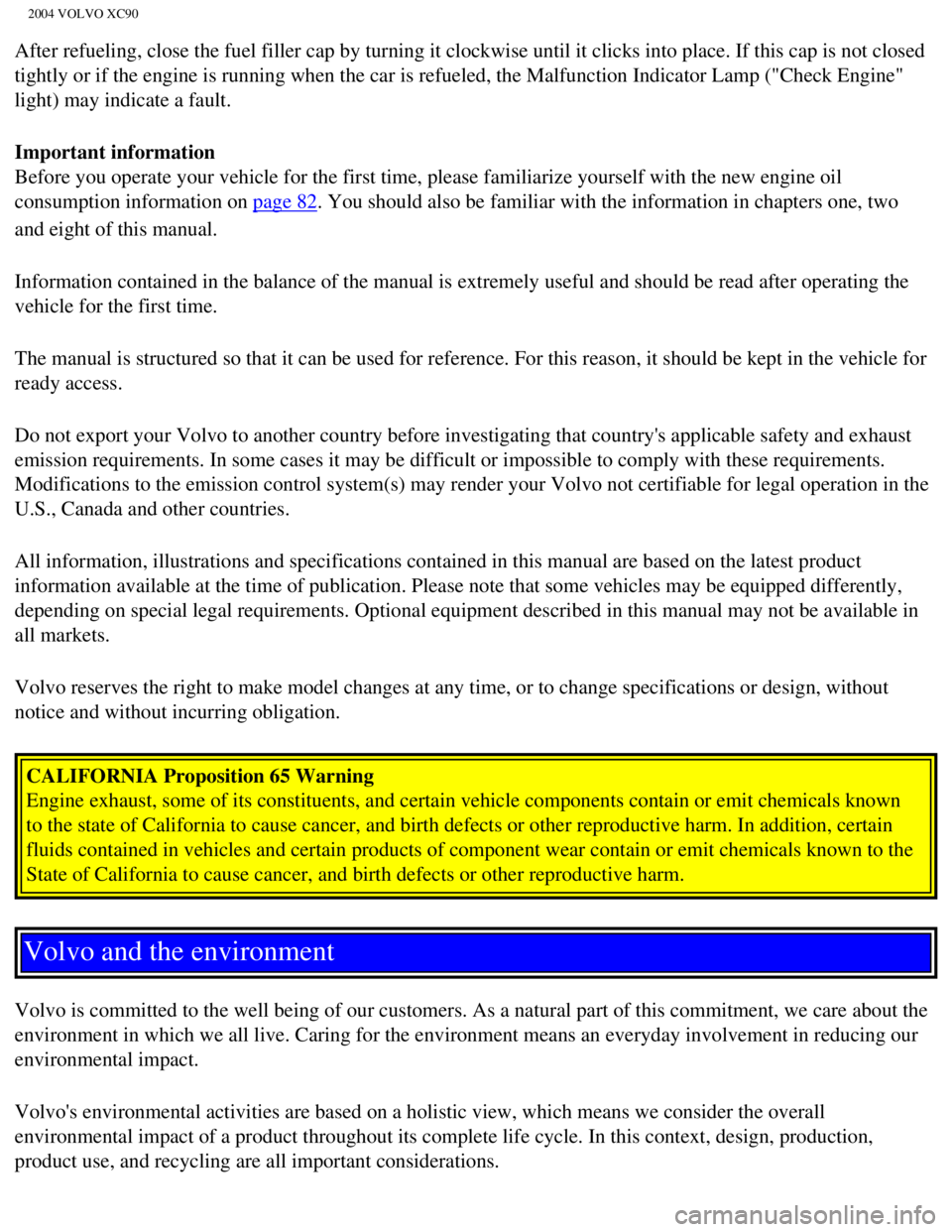
2004 VOLVO XC90
After refueling, close the fuel filler cap by turning it clockwise until\
it clicks into place. If this cap is not closed
tightly or if the engine is running when the car is refueled, the Malfun\
ction Indicator Lamp ("Check Engine"
light) may indicate a fault.
Important information
Before you operate your vehicle for the first time, please familiarize y\
ourself with the new engine oil
consumption information on
page 82. You should also be familiar with the information in chapters one, two \
and eight of this manual.
Information contained in the balance of the manual is extremely useful a\
nd should be read after operating the
vehicle for the first time.
The manual is structured so that it can be used for reference. For this \
reason, it should be kept in the vehicle for
ready access.
Do not export your Volvo to another country before investigating that co\
untry's applicable safety and exhaust
emission requirements. In some cases it may be difficult or impossible t\
o comply with these requirements.
Modifications to the emission control system(s) may render your Volvo \
not certifiable for legal operation in the
U.S., Canada and other countries.
All information, illustrations and specifications contained in this manu\
al are based on the latest product
information available at the time of publication. Please note that some \
vehicles may be equipped differently,
depending on special legal requirements. Optional equipment described in\
this manual may not be available in
all markets.
Volvo reserves the right to make model changes at any time, or to change\
specifications or design, without
notice and without incurring obligation.
CALIFORNIA Proposition 65 Warning
Engine exhaust, some of its constituents, and certain vehicle components\
contain or emit chemicals known
to the state of California to cause cancer, and birth defects or other r\
eproductive harm. In addition, certain
fluids contained in vehicles and certain products of component wear cont\
ain or emit chemicals known to the
State of California to cause cancer, and birth defects or other reproduc\
tive harm.
Volvo and the environment
Volvo is committed to the well being of our customers. As a natural part\
of this commitment, we care about the
environment in which we all live. Caring for the environment means an ev\
eryday involvement in reducing our
environmental impact.
Volvo's environmental activities are based on a holistic view, which mea\
ns we consider the overall
environmental impact of a product throughout its complete life cycle. In\
this context, design, production,
product use, and recycling are all important considerations.
file:///K|/ownersdocs/2004/2004_XC90/04xc90_00.htm (3 of 7)12/30/2006 \
4:35:10 PM
Page 15 of 245

2004 VOLVO XC90
WARNING!
Children must never be allowed in the front passenger's seat. Volvo reco\
mmends that ALL occupants
(adults and children) shorter than 4 feet 7 inches (140 cm) be seate\
d in the back seat of any vehicle
with a front passenger-side airbag. See
page 20 for guidelines.
Occupants in the front passenger's seat must never sit on the edge of th\
e seat, sit leaning toward the
instrument panel or otherwise sit out of position. The occupant's back m\
ust be as upright as comfort
allows and be against the seat back with the seat belt properly fastened\
.
Feet must be on the floor, e.g. not on the dash, seat or out of the wind\
ow.
No objects or accessory equipment, e.g. dashboard covers, may be placed \
on, attached to, or installed
near the SRS hatch (the area above the glove compartment) or the area \
affected by airbag deployment
(see illustration on
page 4).
There should be no loose articles, e.g. coffee cups, on the floor, seat \
or dashboard area.
Never try to open the SRS cover on the steering wheel or the passenger s\
ide dash. This should only be
done by an authorized Volvo service technician.
Failure to follow these instructions can result in injury to the vehicle\
occupants.
Warning light in the instrument panel
A self-diagnostic system incorporated in the sensor monitors the SRS. Th\
is system does not, however,
monitor the Side Impact Protection System (SIPS) airbags. If a fault i\
s detected, the warning light will
illuminate. The light is included in the warning/indicator light cluster\
in the instrument panel. Normally,
the SRS warning lamp should light up when the ignition key is turned to \
positions I, II or III and should
go out after 7 seconds or when the engine is started. Check that this li\
ght is functioning properly every
time the vehicle is started.
The following items are monitored by the self-diagnostic system:
l Sensor unit
l Cable harness
l Gas generator
file:///K|/ownersdocs/2004/2004_XC90/04xc90_01a.htm (8 of 12)12/30/200\
6 4:35:11 PM
Page 37 of 245
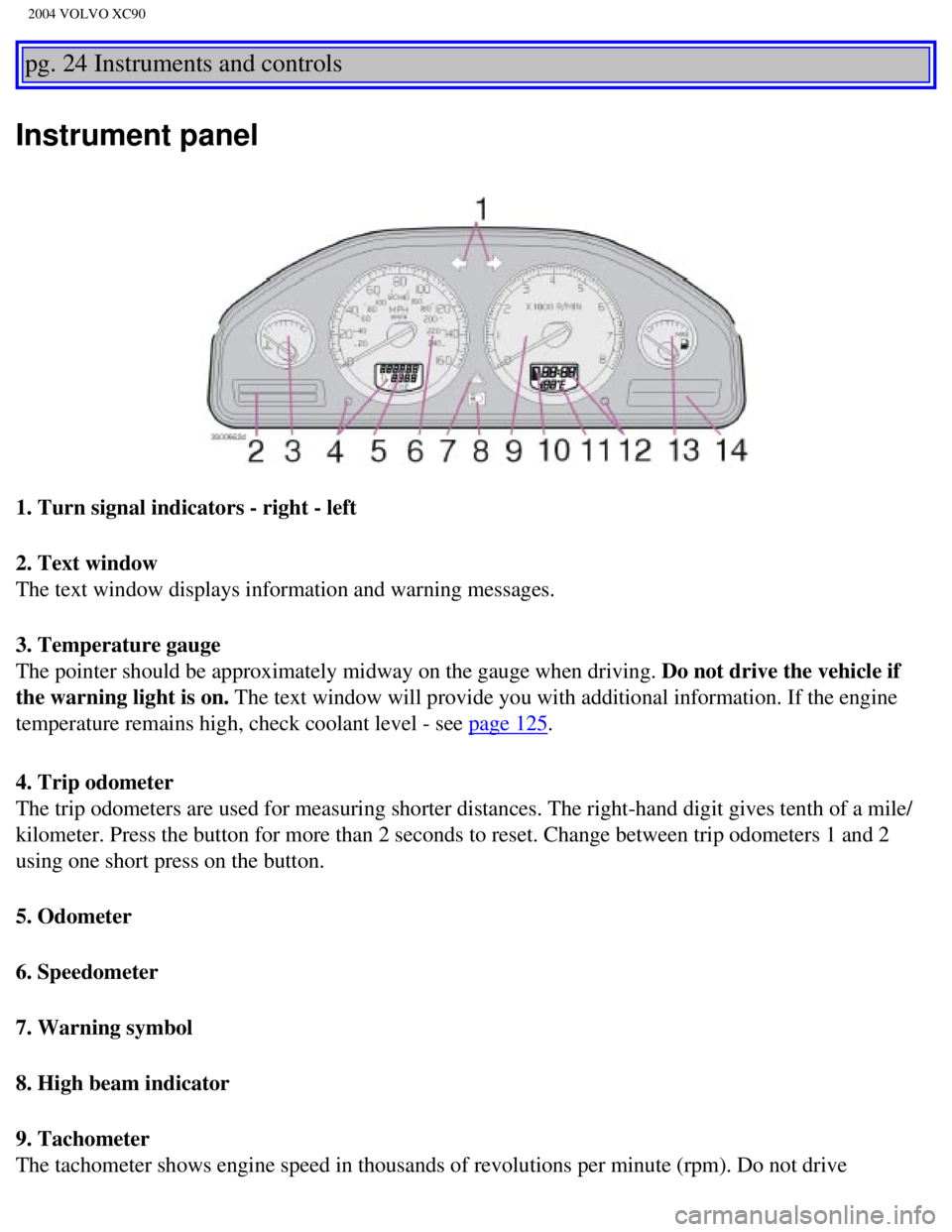
2004 VOLVO XC90
pg. 24 Instruments and controls
Instrument panel
1. Turn signal indicators - right - left
2. Text window
The text window displays information and warning messages.
3. Temperature gauge
The pointer should be approximately midway on the gauge when driving. Do not drive the vehicle if
the warning light is on. The text window will provide you with additional information. If the en\
gine
temperature remains high, check coolant level - see
page 125.
4. Trip odometer
The trip odometers are used for measuring shorter distances. The right-h\
and digit gives tenth of a mile/
kilometer. Press the button for more than 2 seconds to reset. Change bet\
ween trip odometers 1 and 2
using one short press on the button.
5. Odometer
6. Speedometer
7. Warning symbol
8. High beam indicator
9. Tachometer
The tachometer shows engine speed in thousands of revolutions per minute\
(rpm). Do not drive
file:///K|/ownersdocs/2004/2004_XC90/04xc90_02a.htm (2 of 16)12/30/200\
6 4:35:14 PM
Page 38 of 245
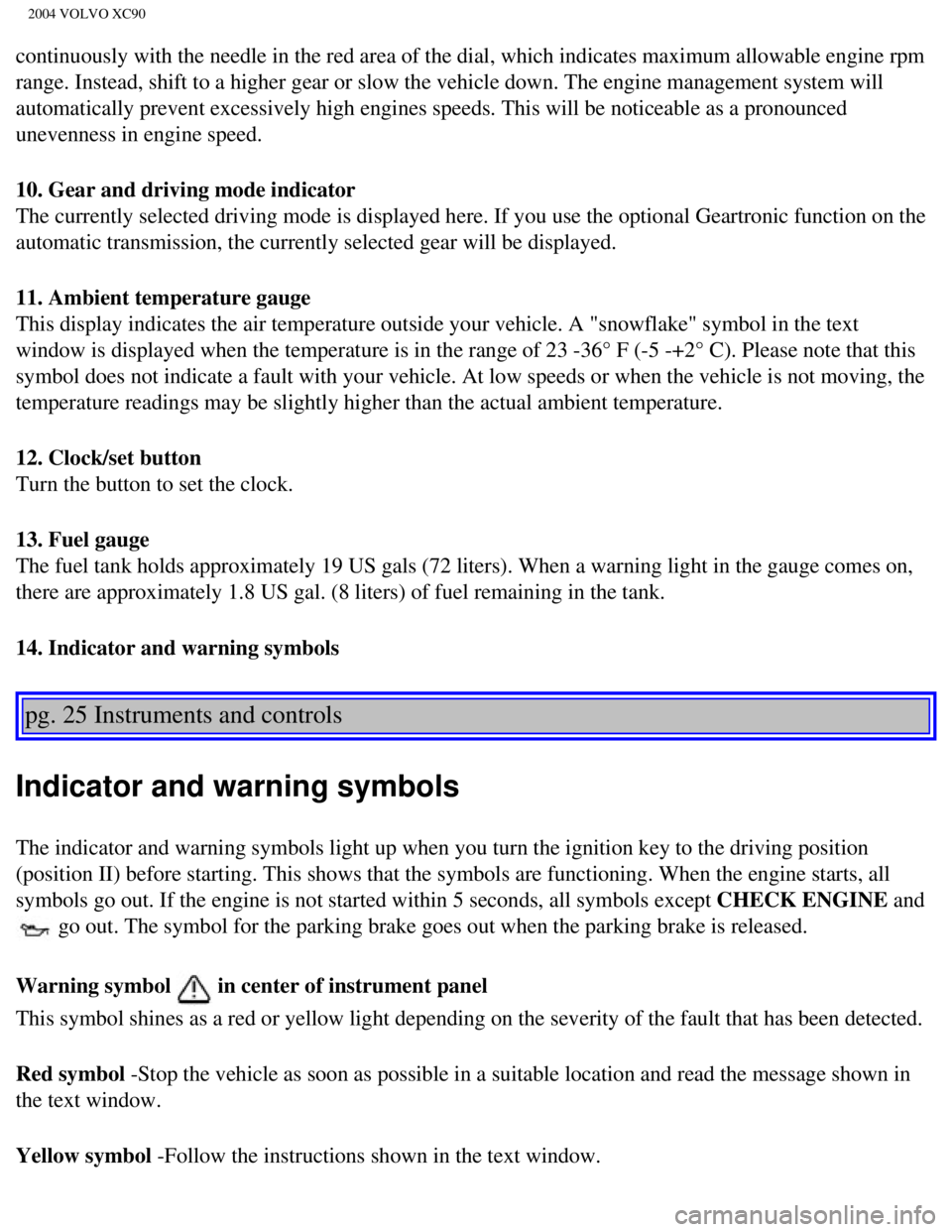
2004 VOLVO XC90
continuously with the needle in the red area of the dial, which indicate\
s maximum allowable engine rpm
range. Instead, shift to a higher gear or slow the vehicle down. The eng\
ine management system will
automatically prevent excessively high engines speeds. This will be noti\
ceable as a pronounced
unevenness in engine speed.
10. Gear and driving mode indicator
The currently selected driving mode is displayed here. If you use the op\
tional Geartronic function on the
automatic transmission, the currently selected gear will be displayed.
11. Ambient temperature gauge
This display indicates the air temperature outside your vehicle. A "snow\
flake" symbol in the text
window is displayed when the temperature is in the range of 23 -36° F\
(-5 -+2° C). Please note that this
symbol does not indicate a fault with your vehicle. At low speeds or whe\
n the vehicle is not moving, the
temperature readings may be slightly higher than the actual ambient temp\
erature.
12. Clock/set button
Turn the button to set the clock.
13. Fuel gauge
The fuel tank holds approximately 19 US gals (72 liters). When a warni\
ng light in the gauge comes on,
there are approximately 1.8 US gal. (8 liters) of fuel remaining in th\
e tank.
14. Indicator and warning symbols
pg. 25 Instruments and controls
Indicator and warning symbols
The indicator and warning symbols light up when you turn the ignition ke\
y to the driving position
(position II) before starting. This shows that the symbols are functio\
ning. When the engine starts, all
symbols go out. If the engine is not started within 5 seconds, all symbo\
ls except CHECK ENGINE and
go out. The symbol for the parking brake goes out when the parking brak\
e is released.
Warning symbol
in center of instrument panel
This symbol shines as a red or yellow light depending on the severity of\
the fault that has been detected.
Red symbol -Stop the vehicle as soon as possible in a suitable location and read th\
e message shown in
the text window.
Yellow symbol -Follow the instructions shown in the text window.
file:///K|/ownersdocs/2004/2004_XC90/04xc90_02a.htm (3 of 16)12/30/200\
6 4:35:14 PM
Page 39 of 245
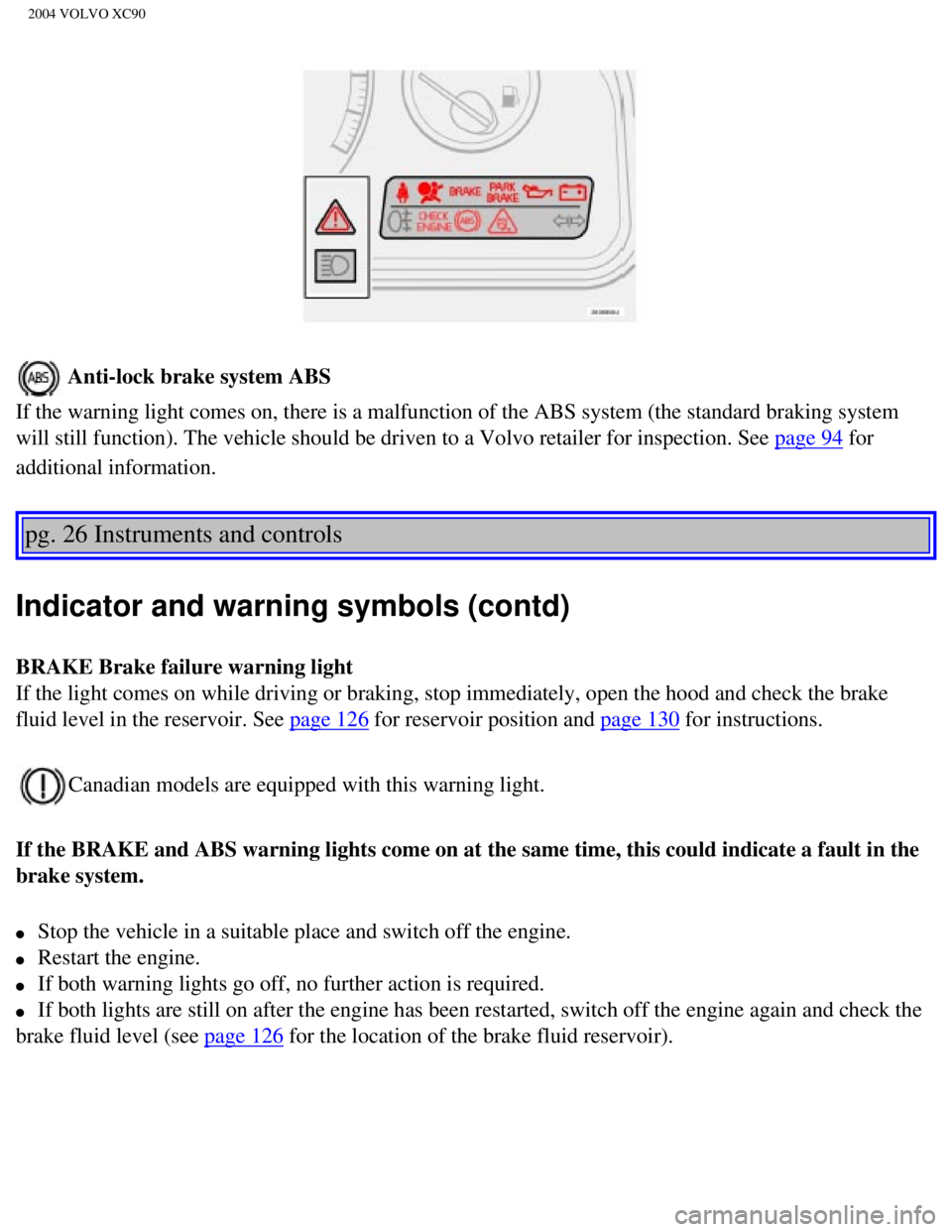
2004 VOLVO XC90
Anti-lock brake system ABS
If the warning light comes on, there is a malfunction of the ABS system \
(the standard braking system
will still function). The vehicle should be driven to a Volvo retailer \
for inspection. See
page 94 for
additional information.
pg. 26 Instruments and controls
Indicator and warning symbols (contd)
BRAKE Brake failure warning light
If the light comes on while driving or braking, stop immediately, open t\
he hood and check the brake
fluid level in the reservoir. See
page 126 for reservoir position and page 130 for instructions.
Canadian models are equipped with this warning light.
If the BRAKE and ABS warning lights come on at the same time, this could\
indicate a fault in the
brake system.
l Stop the vehicle in a suitable place and switch off the engine.
l Restart the engine.
l If both warning lights go off, no further action is required.
l If both lights are still on after the engine has been restarted, switch \
off the engine again and check the
brake fluid level (see
page 126 for the location of the brake fluid reservoir).
file:///K|/ownersdocs/2004/2004_XC90/04xc90_02a.htm (4 of 16)12/30/200\
6 4:35:14 PM
Page 41 of 245
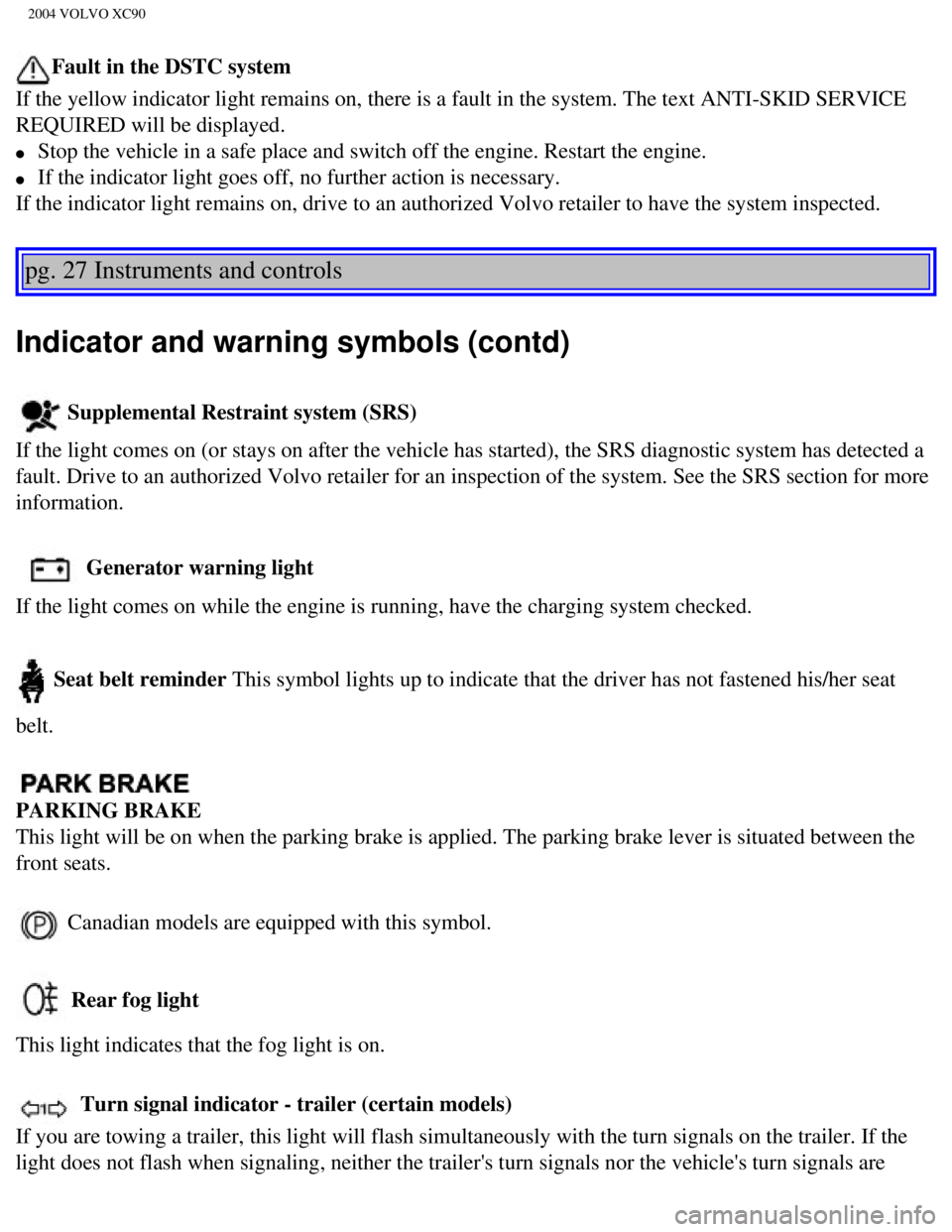
2004 VOLVO XC90
Fault in the DSTC system
If the yellow indicator light remains on, there is a fault in the system\
. The text ANTI-SKID SERVICE
REQUIRED will be displayed.
l Stop the vehicle in a safe place and switch off the engine. Restart the \
engine.
l If the indicator light goes off, no further action is necessary.
If the indicator light remains on, drive to an authorized Volvo retailer\
to have the system inspected.
pg. 27 Instruments and controls
Indicator and warning symbols (contd)
Supplemental Restraint system (SRS)
If the light comes on (or stays on after the vehicle has started), the\
SRS diagnostic system has detected a
fault. Drive to an authorized Volvo retailer for an inspection of the sy\
stem. See the SRS section for more
information.
Generator warning light
If the light comes on while the engine is running, have the charging sys\
tem checked.
Seat belt reminder This symbol lights up to indicate that the driver has not fastened his/\
her seat
belt.
PARKING BRAKE
This light will be on when the parking brake is applied. The parking bra\
ke lever is situated between the
front seats.
Canadian models are equipped with this symbol.
Rear fog light
This light indicates that the fog light is on.
Turn signal indicator - trailer (certain models)
If you are towing a trailer, this light will flash simultaneously with t\
he turn signals on the trailer. If the
light does not flash when signaling, neither the trailer's turn signals \
nor the vehicle's turn signals are
file:///K|/ownersdocs/2004/2004_XC90/04xc90_02a.htm (6 of 16)12/30/200\
6 4:35:14 PM
Page 42 of 245
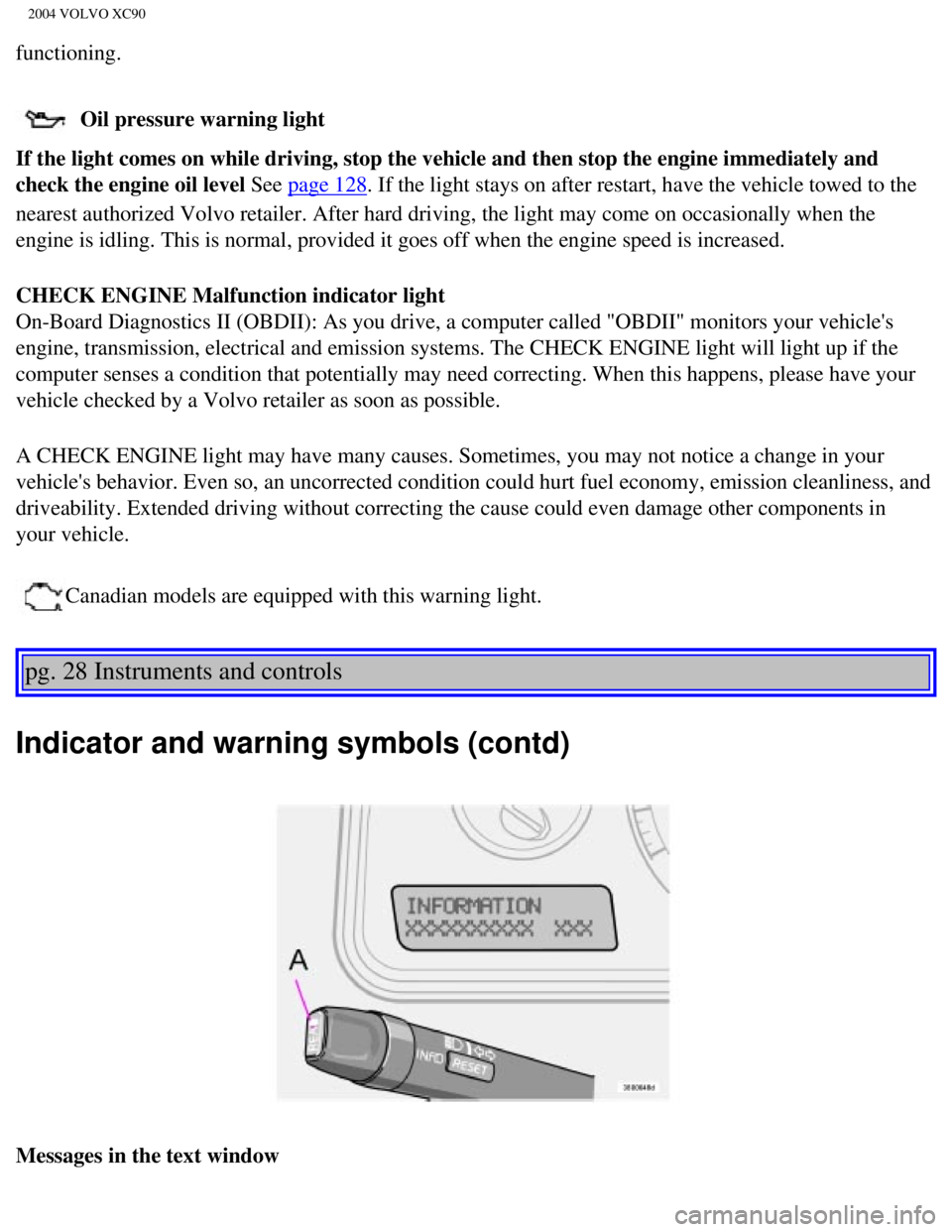
2004 VOLVO XC90
functioning.
Oil pressure warning light
If the light comes on while driving, stop the vehicle and then stop the \
engine immediately and
check the engine oil level See
page 128. If the light stays on after restart, have the vehicle towed to the
nearest authorized Volvo retailer. After hard driving, the light may com\
e on occasionally when the
engine is idling. This is normal, provided it goes off when the engine s\
peed is increased.
CHECK ENGINE Malfunction indicator light
On-Board Diagnostics II (OBDII): As you drive, a computer called "OBDI\
I" monitors your vehicle's
engine, transmission, electrical and emission systems. The CHECK ENGINE \
light will light up if the
computer senses a condition that potentially may need correcting. When t\
his happens, please have your
vehicle checked by a Volvo retailer as soon as possible.
A CHECK ENGINE light may have many causes. Sometimes, you may not notice\
a change in your
vehicle's behavior. Even so, an uncorrected condition could hurt fuel ec\
onomy, emission cleanliness, and
driveability. Extended driving without correcting the cause could even d\
amage other components in
your vehicle.
Canadian models are equipped with this warning light.
pg. 28 Instruments and controls
Indicator and warning symbols (contd)
Messages in the text window
file:///K|/ownersdocs/2004/2004_XC90/04xc90_02a.htm (7 of 16)12/30/200\
6 4:35:14 PM
Page 58 of 245

2004 VOLVO XC90
WARNING!
Always use the parking brake when parking. On hills, also turn the front\
wheels toward the curb.The
indicator light in the instrument panel will light up even if the parkin\
g brake is applied only slightly.
Be sure to press down on the pedal sufficiently.
Opening the hood
Opening/closing the hood
1. Pull the lever (1) located under the left side of the dashboard to \
release the hood lock.
2. Lift the hood slightly.
3. Press up the release control (2) located under the front edge of th\
e hood and lift.
To close the hood, place your hand on it and press down until the hood l\
ocks in the closed position.
WARNING!
l Do not grasp the ribs in the grille when closing the hood. If your finge\
rs protrude through the
grille, they could be injured on components in the engine compartment as\
the grille closes. We
recommend pressing down on the hood to close it.
l Check that the hood locks properly when closed!
pg. 39 Instruments and controls
Opening the tailgate, Auxiliary 12-volt sockets
file:///K|/ownersdocs/2004/2004_XC90/04xc90_02b.htm (7 of 16)12/30/200\
6 4:35:15 PM
Page 108 of 245

2004 VOLVO XC90
pg. 82 Starting and driving
Refueling
ENGINE OIL
Although some oil consumption occurs during normal engine operation, mor\
e oil is consumed when the
engine is new as the internal parts generate higher friction while weari\
ng-in to each other. From the time
the engine is new until the first maintenance is performed, the oil cons\
umption could be higher than
normal. For this reason, it is especially important to check the oil eve\
ry time you refuel your vehicle
during this period. See
page 128.
Fuel requirements
Octane rating
Volvo engines are designed for optimum performance on unleaded premium g\
asoline with an AKI
octane rating of 91 or above. AKI (ANTI KNOCK INDEX) is an average of \
the Research Octane
Number, RON, and the Motor Octane Number, MON. ((RON + MON)/2). The \
minimum octane
requirement is AKI 87 (RON 91).
Deposit control gasoline (detergent additives)
Volvo recommends the use of detergent gasoline to control engine deposit\
s. Detergent gasoline is
effective in keeping injectors and intake valves clean. Consistent use o\
f deposit control gasolines will
help ensure good driveability and fuel economy. If you are not sure whet\
her the gasoline contains
deposit control additives, check with the service station operator.
NOTE: Volvo does not recommend the use of external fuel injector cleaning syst\
ems.
Unleaded fuel
Each Volvo has a three-way catalytic converter and must use only unleade\
d gasoline. U.S. and Canadian
regulations require that pumps delivering unleaded gasoline be labelled \
"UNLEADED". Only these
pumps have nozzles which fit your vehicle's filler inlet. It is unlawful\
to dispense leaded fuel into a
vehicle labelled "unleaded gasoline only". Leaded gasoline damages the t\
hree-way catalytic converter
and the heated oxygen sensor system. Repeated use of leaded gasoline wil\
l lessen the effectiveness of
the emission control system and could result in loss of emission warrant\
y coverage. State and local
vehicle inspection programs will make detection of misfueling easier, po\
ssibly resulting in emission test
failure for misfueled vehicles.
NOTE: Some U.S. and Canadian gasolines contain an octane enhancing additive ca\
lled methyl-
cyclopentadienyl manganese tricarbonyl (MMT). If such fuels are used, \
your Emission Control System
performance may be affected, and the Check Engine Light (malfunction in\
dicator lamp) located on your
instrument panel may light. If this occurs, please return your vehicle t\
o an authorized Volvo retailer for
maintenance.
file:///K|/ownersdocs/2004/2004_XC90/04xc90_06a.htm (2 of 15)12/30/200\
6 4:35:22 PM
Page 111 of 245

2004 VOLVO XC90
as possible when the needle nears the red zone, or when the fuel warning\
light comes on.
WARNING!
Never carry a cell phone that is switched on while refueling your vehicl\
e. If the phone rings, this may
cause a spark that could ignite gasoline fumes, resulting in fire and in\
jury.
CAUTION
- Do not refuel with the engine running *. Turn the ignition off or to p\
osition I. If the ignition is on,
an incorrect reading could occur in the fuel gauge
- After refueling, close the fuel filler cap by turning it clockwise unt\
il it clicks into place*.
- Allow for fuel expansion by not overfilling the tank. Overfilling coul\
d also cause damage to the
emission control systems.
- Avoid spilling gasoline during refueling. In addition to causing damag\
e to the environment,
gasolines containing alcohol can cause damage to painted surfaces, which\
may not be covered under
the New Vehicle Limited Warranty.
- Do not use gasolines containing methanol (methyl alcohol, wood alcoho\
l). This practice can result
in vehicle performance deterioration and can damage critical parts in th\
e fuel system. Such damage
may not be covered under the New Vehicle Limited Warranty.
* If the fuel filler cap is not closed tightly or if the engine is runni\
ng when the vehicle is refueled, the
Check Engine Light (malfunction indicator lamp) may indicate a fault. \
However, your vehicle's
performance will not be affected. Use only Volvo original or approved fu\
el filler caps.
pg. 85 Starting and driving
Starting the engine
1. Fasten the seat belt.
WARNING!
Before starting, check that the seat, steering wheel and mirrors are adj\
usted properly. Make sure the
brake pedal can be depressed completely. Adjust the seat if necessary. S\
ee
pages 54, 56.
2. Apply the parking brake if not already set. The gear selector is lock\
ed in the (P)ark position
(Shiftlock).
Manual transmission: the clutch must be fully depressed.
3. Without touching the accelerator pedal, turn the ignition key* to the\
starting position. Allow the
file:///K|/ownersdocs/2004/2004_XC90/04xc90_06a.htm (5 of 15)12/30/200\
6 4:35:22 PM